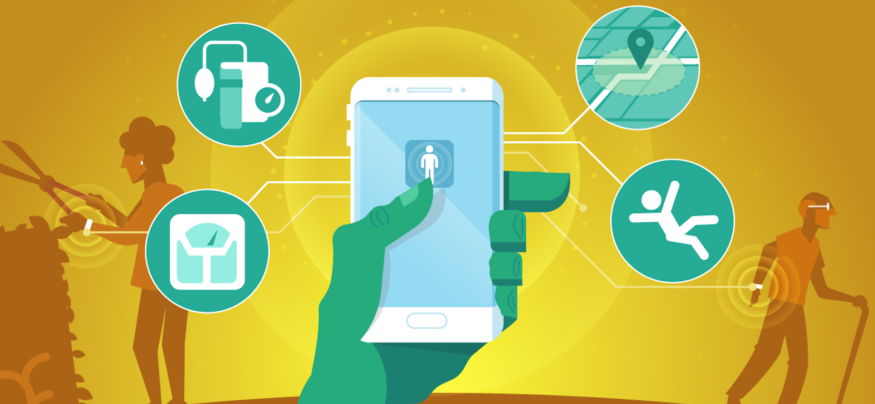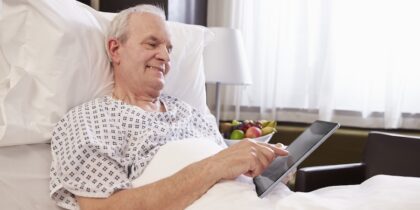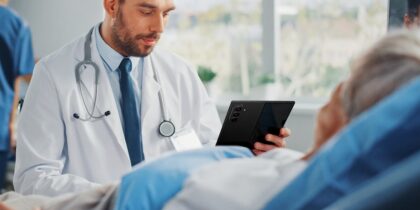These days, it seems everyone is toting, tapping or talking on a smartphone. Everyone, that is, except for older adults.
Only 18 percent of older Americans have adopted smartphones, according to a 2014 report from the Pew Research Center. And that’s a shame. Not only do smartphones keep older adults connected to the outside world, but also they make great remote monitoring devices.
Multiple companies are working to make smartphones and tablets more accessible to older adults. For example, Dutch innovator Gociety Solutions wants to turn smartphones into “smart companions” for aging adults. According to Gociety’s research, 30 percent of older adults feel lonely, 16 percent feel unsafe and 15 percent don’t even go outside their homes.
To help address the challenges of aging, Gociety developed an easy-to-use software solution for smartphones that keeps older adults connected to loved ones and healthcare providers. “Older adults see the rest of society using these devices and they feel excluded,” says Frank Verbeek, chief executive officer of Gociety Solutions. “We offer them a step-by-step approach to adapt to this technology.”
Just as importantly, smartphones can help older adults take an active role in their personal care, safety and well-being.
How Can You Ensure the Security of Health Apps?
Download this white paper for a free guide to mobile security in healthcare. Download Now
Four Remote Health Monitoring Benefits
On the front end, Gociety’s software simplifies the smartphone’s user interface for older adults. On the back end, it adds sophisticated remote care functionality via GoLive Assist, which tracks and monitors health data, and communicates changes to health providers and caregivers.
By turning smartphones into remote monitoring devices, Gociety Solutions offers the following benefits:
-
Fall prevention and detection: Along with Fraunhofer Portugal, a leading research and development institute on aging, Gociety has developed algorithms that use a smartphone’s sensors to track gait speed, walking asymmetry, overall activity levels and speed of sitting-to-standing transitions. “We use this data to determine the risk of falling,” says Verbeek. “If the risk goes up, older adults can talk to their healthcare providers about physical therapy to improve balance and coordination.” If they fall, approved caregivers automatically receive alerts with the senior’s exact coordinates.
-
Biometric trend analysis: The solution integrates Bluetooth-powered biometric devices — oximeters, weight scales and blood pressure cuffs — to track health data trends and alert healthcare providers to abnormalities.
-
Wearable integration: For sensors to work, users must carry smartphones on their bodies. But when they wear clothes without pockets or shower, this isn’t possible. “That’s why we developed GoLive Wear,” says Verbeek. “It includes all the important sensors and connects to the smartphone via Bluetooth. If a patient falls in the bathroom, we can track her and a call for help will be sent out automatically.”
-
Caregiver support: Approved caregivers can see where users are, where they’ve been, and how they’re getting around. “This gives caregivers peace of mind and helps them locate lost seniors,” says Algis Leveckis, vice president of U.S. operations at Gociety Solutions. The software includes the ability to create geofencing around users’ homes, neighborhoods or cities. “When older adults cross a boundary, an alert is sent to the caregiver. The senior also gets a notification asking, ‘Are you ok? Do you know where you are?’ If they don’t know, they can push a button and get directions home.”
Putting Fun at the Forefront
Gociety Solutions has a group of 400 test users between ages 55 and 94. Based on their feedback, the company has determined that older adults aren’t always interested in remote monitoring devices. Verbeek explains, “Max, our oldest test user at 95 years old, told me, ‘Fall detection is very nice, but that’s for older people, not for me.’ For them, remote monitoring seems stigmatizing.”
Leveckis agrees. After delivering a presentation at a recent telehealth conference, he was approached by a surgeon who uses remote monitoring devices for older adults after surgery. “Most people don’t want to be constantly looking at their health data. It would be like having a financial application that keeps telling you how far in debt you are. You wouldn’t want to see that every day. So, we’ve created an integrated device that keeps the things that are important to users front and center, and then in the background we are watching for problems.”
Coming to America
Gociety Solutions already has more than 10,000 customers in Europe. Now, through a partnership with Samsung, the company is in negotiations with wireless carriers and hopes to offer the solution to U.S. consumers and healthcare providers in 2016.
Although Gociety’s solution will work on other Android phones, Verbeek says the company advises customers to use Samsung Galaxy smartphones. “The sensors are very sophisticated and the battery capacity is stronger,” he explains. “With the Samsung Galaxy, we can guarantee usage around 16 hours. Even when the phone is in sleeping mode, the sensors continue to work 100 percent. Many other manufacturers switch off or lower capacity of sensors when phones are in sleep mode to conserve battery, and then it is not very usable any longer.”
Explore more healthcare technology solutions that can enhance efficiencies and improve the patient experience.








